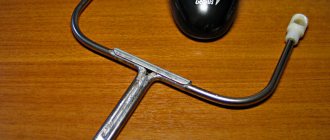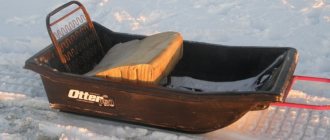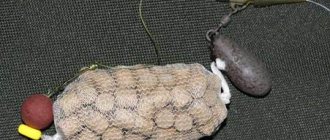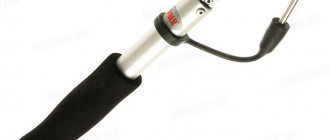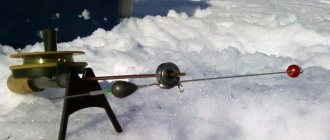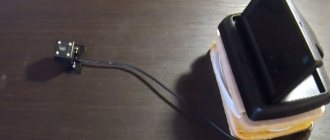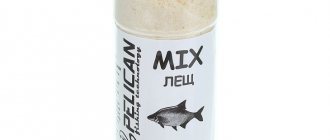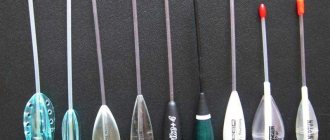Yuri 02.11.2020 224
Today, fishermen in search of a large trophy come up with such sophisticated fishing methods that even seasoned sports fishermen will envy them. One such sophistication is fishing clay. How effective is such a nozzle, and how to use it correctly – we’ll talk about this later.
What is plasticine for fishing
Fishing plasticine is a ready-to-use mixture sold in specialized stores, intended for use as groundbait or bait. It is mainly chosen for catching peaceful fish using a spring or feeder, as well as for ice fishing.
The composition contains only natural ingredients: crushed corn grains, hemp seeds, pea kernels, garlic, etc.
Plasticine is enriched with betaine, which is very attractive to fish, and a whole complex of amino acids. At the same time, it is absolutely safe for water bodies, since no preservatives or artificial colors are used in its production.
What is fishing clay
Content
Fishing plasticine is a special mixture prepared from dense and viscous components, reminiscent of ordinary children's plasticine. The substance feels very sticky and has high viscosity. In fishing it is used as a bait or bait. The product contains natural substances of plant origin and special additives to enhance nutritional properties. Plasticine is used as bait for carp, crucian carp, bream, etc., as it has a special, expressive aroma that attracts prey.
Fishing plasticine is one of the interesting products for fishing
When preparing plasticine you should use:
- components with a large amount of carbohydrates, proteins and amino acids;
- flavorings to attract the attention of prey: vanilla, spices, garlic, hemp;
- fine-grained peas and chopped corn.
The composition at the base of this mixture can be extremely varied, it all depends on the type of fish being hunted. It is possible to make plasticine at home with your own hands, but it is also sold in stores. The main difference between purchased complementary foods is the presence of betaine - this is a widespread attractant, used to catch fish that hunt mollusks, crustaceans or feed on plants. The reason for the effectiveness is the presence of betaine in the listed animal and plant foods; the fish smells and reacts positively to bait.
Now we may mistakenly think that plasticine is a type of bait. This composition is really suitable for bait, but in the absence of another mixture. Most often, this product is used to achieve other goals - use as bait and groundbait for certain types of gear, for which the use of other mixtures is difficult.
This mass is mainly used:
- when fishing with a spring, it prevents the mixture from scattering while testing fish;
- for feeder gear. Used on bodies of water with currents, where conventional mixtures are washed out too quickly. Another task of plasticine is long-term fishing without recasting; fishermen often set the fishing rod all night and return in the morning to check the gear. The resorption time of the composition sometimes reaches 2 days;
- Plasticine is ideal for making nipples. The fish absorbs the mixture, and when it feels the metal, it spits out the hook and hooks itself.
Read more
Basic requirements for trout wobblers and how to choose?

The composition at the base of this mixture is extremely varied.
Advantages of plasticine in comparison with other baits and baits for fishing:
- resistant to crumbling;
- does not fall off the hook, plasticine can also be used even as large attachments;
- it is slowly washed out, and the aroma of plasticine is released for a long time;
- allows you not to change the nozzle during frequent recasts;
- It not only smells good, but also tastes good.
It is a successful composition for catching carp in strong current conditions. In stagnant reservoirs it is used less frequently, since there is no need for a high density of the composition.
Types of plasticine
The entire range of this type of bait can be divided into 2 large groups depending on:
- fishing object;
- aromatic additives used.
In accordance with the size and variety of fish for which the bait is intended, the product for fishing can be selected:
- Large (crucian carp, carp, etc.) fish. This mixture, as a rule, has fruit aromas, is quite viscous and holds well in the feeder and on the hook, and also does not fall off when colliding with the water surface during casts (including repeated ones). The time when the plasticine completely dissolves without leaving any cloudy sediment is about 1.30 hours.
- Freshwater fish of all sizes. A special feature of this type is the creation of an oily cloud containing amino acids and aromas attractive to fish. Well recommended both when fishing in the current and in reservoirs with standing water. Sold ready to use.
Depending on the aromatic additives used, the following options are distinguished:
- Fruity and fruit-berry aroma (apple, plum, strawberry, etc.). It is especially effective when catching large-sized fish, since it is enriched with proteins and amino acids that are attractive to this type of fish. Color – deep red. The mixture has a high degree of viscosity and is suitable for use with any types of feeders. No dilution with liquid is required. Suitable for summer fishing.
- Pea aroma. In addition to the main component in the form of crushed peas, the composition contains milk, a vitamin and antioxidant complex, and essential oils. Does not contain artificial components and is safe for the environment. This option has proven itself excellent when fishing for carp. Indispensable in the spring-autumn period, when strong aromas are needed.
- Hemp aroma. Includes hemp waste. It is preferred by most species of the carp family. All-season product.
- Garlic aroma. Strong and resilient. It contains ground garlic, so this bait leaves behind an oily trail that attracts fish from a long distance.
- Honey aroma. Ideal for summer fishing. It has a sweetish and very attractive smell for cyprinids.
- Corn aroma. An excellent summer complementary food for white fish. Effectively replaces regular corn grains.
- Vanilla aroma. This option is universal and suitable for freshwater fish of any family, regardless of size. The grain component is supplemented with natural aromatic components.
How to fish with plasticine
Now let’s consider from the height of fishing experience how you can use plasticine directly on a pond. At the same time, we will analyze several typical situations of its use.
In a stagnant pond
How to make a mask for fishing with your own hands
On a simple rural pond, it is quite possible to fish with plasticine, using it as a bait on a hook. In this way you can catch the most popular peaceful fish:
- crucian carp;
- carp;
- roach;
- minnow;
- rudd;
- bleak.
A piece is separated from the total mass, from which, in turn, balls or sausages of the required size are formed, depending on the type of intended prey.
At the same time, part of the bait is mixed with baking powder, forming groundbait. The following can be used as fillers:
- ground crackers;
- sunflower cake passed through a meat grinder;
- crushed cereals;
- priming.

Various flavorings can also be added to the mixture with plasticine to make the bait more saturated.
For big fish
To catch large fish such as carp, you need to do things a little differently. Firstly, the balls are formed larger. Secondly, they can be mounted not only by direct attachment to the hook, but also using hair accessories.
Attention! Hair mounting allows you to more effectively use the ability of carp to self-hook when biting.
In addition, you need to wind many smaller balls to feed the fishing point, similar to the use of bait boilies. They are cast by a cobra, a rocket or from a boat.
Advantages and disadvantages
Different flavors of plasticine for fish
Fishing plasticine has a number of advantages that significantly distinguish it from other types of bait:
- Viscosity and density. Thanks to these qualities, plasticine takes on any desired shape and size, without crumbling into small components. It is effective when used in any type of feeder and is also securely fixed on hooks. It doesn't fly off when it hits water. It does not wash out for a long time and does not leave a cloudy mark.
- Unique composition. Includes components of natural origin, as well as bite activators. Enriched with amino acids and nutritious proteins. Designed taking into account the needs and characteristics of a specific type of fish. Safe for representatives of flora and fauna of water bodies.
- Versatility of use. Suitable for both ponds with standing water and flowing water.
- Practicality. Does not require special storage conditions or separate containers. The lid must be tightly closed after each use. In case of long-term storage it hardens. To reuse, simply soak it in water to the desired consistency.
- Unpretentiousness. The mixture is completely ready for use. Does not require pre-soaking, heating or diluting with liquid.
- Economical. The product costs little. One package is enough for several fishing trips.
Among the main disadvantages of this mixture it is worth noting:
- Quite a high price. Homemade porridge or homemade mixture will cost much less.
- Features of product sales. Plasticine is sold in specialized stores, which are not available in all small towns, as well as through online stores with delivery to a limited list of cities.
- Absence of cloud or pillar (except for certain species). This type of bait does not spread over significant distances and different water columns.
Methods of use: how to catch
This mixture has several uses:
- As an effective bait that targets specific fish and does not require any preparation. You just need to open the sealed package, take out the required amount of plasticine and use it with any type of feeder. Or form small balls and lure the fish to the upcoming fishing spot. Due to its viscosity, this bait does not get wet for a long time and has an attractive taste and color.
- As bait, bait small pieces of product directly onto the hook instead of regular dough. Used when fishing for representatives of the carp family.
- As a soluble boilie. To do this, the mixture should be slightly dried in the sun. This will take very little time, so you can perform a simple procedure immediately before fishing. To attach such a boilie, hair equipment is used. This method is effective when fishing for carp.
Tips for using plasticine for fishing
When finished, the mixture should turn out to be spherical, which is convenient to place on the hook and hide the sting. Since fishing plasticine can be used in different ways, it is important to first take into account the size, mouth size and habits of the fish being hunted.
Fishing plasticine how to use:
- in the form of a dusty boilie. Separately, we cast a ball on a fishing rod, which gradually spreads the aroma throughout the area. At this time, we calmly fish, checking the condition of the boilie at short intervals;
- as bait. We divide the entire mass into small balls and throw them into the water like regular bait;
- as bait. We make a ball of a suitable size for the fish’s mouth. We put it on a hook instead of bait.
Additional tips for use:
- we feed the fish first, then fishing will be more effective;
- we take into account the long process of aromatic substances atomization;
- We recommend adding grain components to the finished mixture;
- When preparing the composition with our own hands, we use exclusively fresh ingredients; fish will not bite on old products;
- add water in small quantities, it is better to immediately stock up on it from the selected reservoir;
- the best results are shown by natural flavors that imitate the smells familiar to fish;
- experienced fishermen add milk to the composition; it has an astringent effect and leaves a white spot on the water.
By making fishing clay and fishing tackle with your own hands, you can save 2-3 times. Unfortunately, it will not be possible to achieve equal effectiveness of homemade and purchased plasticine due to the difficulty of extracting betaine, but the catch still promises to be plentiful.
Cost and shelf life
The cost of fishing plasticine is relatively low. Manufacturers offer various options for this mixture by weight - from 50 grams to 1 kilogram. In accordance with this, the price range is different: 50-200 rubles.
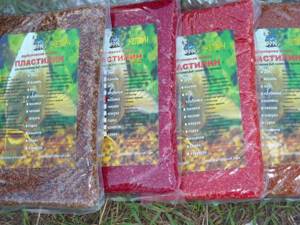
Fishing plasticine can be purchased at any specialized fishing stores.
Thus, if you have not yet decided to completely abandon traditional baits or lures in favor of plasticine, then buying one package of this product will not greatly impact your budget.
In addition, the shelf life is quite long - 1 year. Storage conditions are simple: tightly closed lid to prevent the composition from hardening and deterioration of natural ingredients, maintaining a storage temperature of 5-25 degrees.
When purchasing, be sure to pay attention to the manufacturer. After all, the result will depend on the quality of the product. Today, fishermen are offered a huge range of baits with various flavoring additives, as well as taking into account the characteristics of the fishing object.
When purchasing a product through online stores, pay attention to the cost and delivery conditions (especially in the cold season, because strict adherence to temperature conditions is necessary), as well as possible seasonal offers and discounts.
Do-it-yourself plasticine for fishing
There are options for making a universal plasticine mixture, as well as one aimed at specific fish.
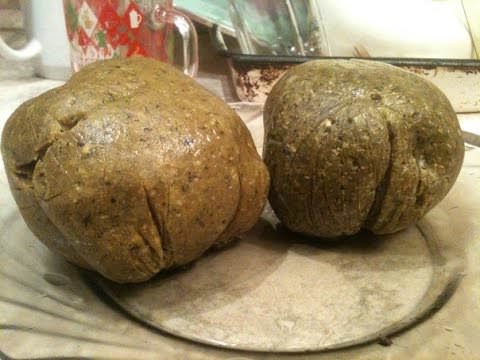
Universal mixture
To prepare this type of complementary food we will need:
- Sunflower cake and halva in a one to one ratio.
- It is possible to use vanilla sugar, crushed hemp, wheat bran, garlic, etc. as natural flavoring and aromatic additives.
Preparation:
- Grind the sunflower cake using a meat grinder.
- In a separate container, knead the halva until smooth. It's better to do it by hand.
- Gradually add the pulp and mix thoroughly for 15-20 minutes. The consistency of the finished product should be viscous and viscous.
- We add any selected ingredient (sugar, garlic, etc.) to the resulting mass, taking into account the preferences of the fished object and the season.
- We quickly form boilies of the required size. Please note that after a few minutes the mass will harden and it will no longer be possible to knead it again.
For catching crucian carp
First option. Required ingredients: peas, semolina.
Cooking technology:
- Soak the peas in a container of water overnight, but no more than 12 hours.
- We pass the swollen peas through a meat grinder several times.
- Add semolina in small portions and bring to the required consistency.
Second option. Necessary ingredients: potato tubers, corn flour, rye bread, sunflower oil. The preparation technology is similar to that described above.
For catching bream
Ingredients needed: peas, spoon of honey:
- Pre-soak the peas until completely swollen.
- Place the peas in boiling water and boil for several hours.
- Drain the water and add honey.
For carp fishing
Required ingredients: potato tubers, peas, semolina:
- Boil the potatoes in their skins, cool and peel. Make puree.
- Take 4 parts of prepared peas and 6 parts of mashed potatoes. Add semolina and cook as usual.
- If necessary, you can add flour to bring the mixture to the desired consistency.
Plasticine for fishing: types and techniques of use
15.04.2016Plasticine has widely proven itself among many current fishermen, since it can significantly save time when preparing for fishing. This bait is many times superior to porridge cooked according to individual recipes, both in terms of ease of storage and degree of effectiveness.
The basic components of the plasticine offered for sale are hemp grains, peas, corn, cake, as well as a number of additional components that have a positive effect on attracting fish.
Each type of bait is designed for catching a specific fish, having both its pros and cons.
Thus, plasticine for fishing has the following advantages:
- Practicality. For storage, you don’t need to look for a container of a special design that would allow you to maintain its working condition. When purchasing it in sealed packaging, it is important to remember one rule - avoid long-term storage in hot conditions.
- Density and viscosity. The plasticity of this complementary feeding mixture allows plasticine to be given any fixed shape that lasts for a very long time.
- Versatility. Plasticine is ideal for both artificial and natural reservoirs.
- Specialization. When going fishing, you can purchase a strictly defined type of mixture that will allow you to catch the desired type of fish.
- Static. Due to its plasticity, the mixture works successfully on rivers with strong currents.
- Nutritional value. The components included in the composition allow you to attract fish even from afar and reliably hold it in the place of intended fishing.
- Durability. Even when used on fast-flowing rivers, plasticine will last much longer than regular bait.
- Ease of use. To prepare it, no major manipulations are required: just open the package and use it!
- Strength. Since plasticine withstands the impact of the water surface, it can be successfully used for long casts.
Now let's note a couple of negative points:
- Price. For all its excellent quality, plasticine will be somewhat more expensive than cooked porridge from homemade ingredients.
- Low prevalence. Since plasticine is a new product in the field of sport fishing, this product is not available in every region of our country, even in specialized online stores.
Types of plasticine
The group division of plasticine is represented by two tasks for which it is designed:
- To attract a specific type of fish
— For trophy fishing. The mixture contains special components and nutrients that are of interest to fish. The most attractive quality is the fruity aroma. At the same time, plasticine allows you to give it any shape, and also differs in the duration of its preservation even during the flow.
— For fishing on freshwater rivers and lakes. More versatile in terms of the size of the ichthyofauna representatives it attracts. No pre-soaking required makes it a convenient way to attract fish of any size. The presence of special oils and amino acids in the mixture provides a “cloud” at the site of complementary feeding, which not only attracts, but also retains the fish for a long time.
- Flavoring varieties of plasticine
- Peas. Plasticine contains both peas and a whole set of aromatic components, which, taken together, will not leave any fish indifferent.
- Fruits. The rich color and smell make this mixture an excellent bait for any body of water.
- Hemp. The basic component is waste from the processing of hemp stems and leaves.
- Honey. The mixture is quite sweet to taste, however, the fish simply will not be able to leave the place it feeds.
- Garlic. The specific attributes of this plasticine are an oil trace in the water and a pungent odor.
- Corn. It is advisable to introduce the fish to corn grains in advance, because... such a mixture requires some getting used to and mastering by the objects of fishing.
- Vanilla.
The type of plasticine you choose should be based on the season. So, in the summer, when the water is warm enough, there will be enough soft, sweet odors. As for the off-season, when the fish are quite passive to bites, you should rely on more extravagant options: garlic, peas, etc.
How to lure fish with plasticine
- Boyle. The classic spherical shape, made of plasticine, is guaranteed to last in water for a fairly long period of time. Boyle creates an aromatic “cloud” around himself that will hold the fish and will also consistently attract new specimens.
- Lure. Plasticine can also be used as regular bait by making small balls from it, which should be thrown before starting fishing.
- Bait. The versatility of this mixture also allows it to be used as an alternative to stored types of bait. A small ball will successfully replace bread, dough, semolina, corn, and most importantly, it will provide the fisherman with a cage with an enviable number of worthy specimens.
As for the cost of plasticine, you can purchase one package in a specialized fishing store for about 200 rubles. If you want to get a foreign original product, then ordering from a foreign website with delivery will cost a little more.
Making plasticine for fishing with your own hands
There are only three basic components for making plasticine:
- cake,
- vanilla sugar,
- halva
The sequence of actions is also quite trivial and will not create problems even for a novice fisherman:
- Knead the halva until smooth.
- Add the cake.
- Continue stirring for about 20 minutes to obtain a plastic, viscous mass.
- Add vanilla sugar, the smell of which is especially attractive to fish.
- To save time, you can prepare plasticine balls before you go fishing.
Taking into account the components included in this mixture, it is worth noting that it is excellent for catching carp.
Tips and tricks
- When making plasticine yourself, choose only fresh products, otherwise complementary foods will not attract, but rather will scare away the fish. And for a long time.
- Since plasticine hardens quickly, to re-knead it, it is enough to moisten it with water in moderation. It is better if it is water from the reservoir where fishing takes place.
- Adding dry milk to homemade plasticine will create a cloudy “cloud” in the water, which will be visible to the fish from afar and will keep it in one place for a long time.
- Don't be afraid to add vanillin or sweet, aromatic confectionery gingerbread to the mixture.
- For the greatest savings on a purchased package of plasticine, just mix it with a homemade mixture in a 1:1 ratio.
- If you want to catch large carp, carp or crucian carp, add sweet corn or a certain amount of live maggots to the mixture.
Follow the rule: “the more, the better.” And then plasticine with large components and no less small bait on the hook will guarantee the capture of a trophy specimen!
Recommendations for use
- When forming balls, it is necessary to take into account the size of the fishing object, and proceed from the rule: the larger the ball, the larger the catch.
- You need to place plasticine on the hook so that the tip and barb of the hook remain inside the ball. Otherwise, the fish may simply slip off.
- To prepare your own vegetable bait, you must use only fresh ingredients. Do not leave finished products exposed to sunlight.
- In order for the mass to have the desired consistency, you can add water from a reservoir with clean water.
- It is better to include natural ingredients in the composition: milk powder to form a cloud, vanillin to add flavor, corn for catching any large fish, maggots for representatives of the carp family, etc.
- Plasticine prepared at home can be mixed in equal proportions with purchased plasticine.
Advantages and disadvantages of using fishing plasticine
Plasticine has a lot of advantages that can improve fishing efficiency:
- ease of making bait that is resistant to currents;
- there is no need for preliminary preparation of the substance;
- actively used as a bait due to its stability on the hook;
- easy to use for filling feeders;
- due to the presence of betaine, river fish actively and sharply attack the bait;
- maintains its correct shape for a long time;
- Practical in most areas of fishing.
The only disadvantage of the substance is its high cost; store-bought mixtures are always more expensive than home-prepared ones.
Blitz tips
- The use of plasticine is especially effective if the fishing area has previously been baited.
- This bait dissolves quite slowly. Therefore, if necessary, you can add oatmeal or flour to speed up the blurring process.

It is important to remember that you should not pin your hopes only on correctly chosen complementary foods. It is necessary to take into account many factors, both dependent on the fisherman (correct equipment, place and time of fishing, etc.) and independent (weather and temperature conditions, etc.).
